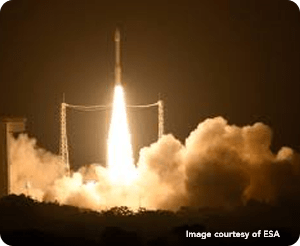Lisa Pathfinder lifts off successfully

After solving a technical hitch that delayed the lift-off past the scheduled time, ESA’s LISA Pathfinder mission successfully blasted off on 3 December onboard a Vega rocket from Europe’s Spaceport in Kourou, French Guiana, on its way to demonstrate technology for observing gravitational waves from space..
LISA Pathfinder has been developed by an industrial consortium primed by Airbus Defence & Space Ltd. Airbus Defence & Space GmbH is responsible for the mission’s payload or LTP (LISA Technology Package), which has been developed by a consortium of European research centers and companies.
GMV has played a key role in this consortium. Some of its most important activities are validation of LTP software; mission analysis support and orbit control from the European Space Operations Centre (ESOC); plus support for science data management from the European Space Astronomy Centre (ESAC).
LISA Pathfinder will be trialing the necessary technology for detecting gravitational waves in space. At its core is a pair of identical 46 mm gold–platinum cubes separated by 38 cm, which will be isolated from all external and internal forces acting on them except one: gravity.
The mission will put these cubes in the purest free-fall ever produced in space and monitor their relative positions with astonishing precision, paving the way for future gravitational wave observatories in space.
Over the next two weeks, the spacecraft itself will raise the orbit’s highest point in six critical burns. The final burn will propel the spacecraft towards its operational location.
This is an unprecedented technological development that will open a new window onto investigation of the universe.